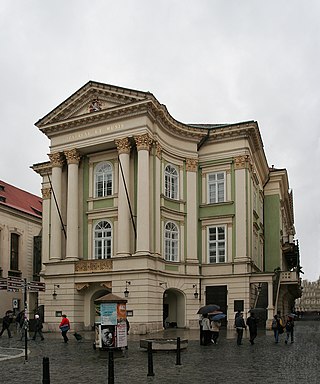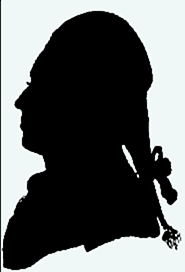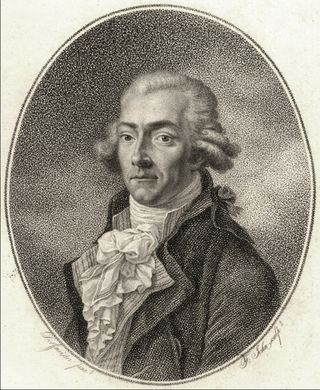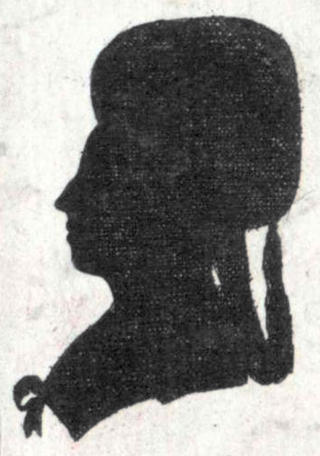
Antonio Salieri was an Italian composer and teacher of the classical period. He was born in Legnago, south of Verona, in the Republic of Venice, and spent his adult life and career as a subject of the Habsburg monarchy.

Don Giovanni is an opera in two acts with music by Wolfgang Amadeus Mozart to an Italian libretto by Lorenzo Da Ponte. Its subject is a centuries-old Spanish legend about a libertine as told by playwright Tirso de Molina in his 1630 play El burlador de Sevilla y convidado de piedra. It is a dramma giocoso blending comedy, melodrama and supernatural elements. It was premiered by the Prague Italian opera at the National Theatre, now called the Estates Theatre, on 29 October 1787. Don Giovanni is regarded as one of the greatest operas of all time, and has proved a fruitful subject for commentary in its own right; critic Fiona Maddocks has described it as one of Mozart's "trio of masterpieces with librettos by Da Ponte".
The year 1791 in music involved some significant events.

La clemenza di Tito, K. 621, is an opera seria in two acts composed by Wolfgang Amadeus Mozart to an Italian libretto by Caterino Mazzolà, after Pietro Metastasio. Mozart completed the work in the midst of composing Die Zauberflöte, his last opera. La clemenza di Tito premiered on 6 September 1791 at the Estates Theatre in Prague.

Michael Kelly was an Irish tenor, composer and theatrical manager who made an international career of importance in musical history. One of the leading figures in British musical theatre around the turn of the nineteenth century, he was a close associate of playwright and poet Richard Brinsley Sheridan. He also became friends with musicians such as Mozart and Paisiello, and created roles for the operas of both composers. With his friend and fellow singer Nancy Storace, he was one of the first tenors of that era from Britain and Ireland to become famous in Italy and Austria. In Italy he was also known as O'Kelly or even Signor Ochelli. Although the primary source for his life is his Reminiscences, doubt has been cast on the reliability of his own account, and it has been said that '[a]ny statement of Kelly's is immediately suspect.'

Stephen John Seymour Storace was an English composer of the Classical era, known primarily for his operas. His sister was the famous opera singer Nancy Storace.

Lorenzo Da Ponte was an Italian, later American, opera librettist, poet and Roman Catholic priest. He wrote the libretti for 28 operas by 11 composers, including three of Mozart's most celebrated operas: The Marriage of Figaro (1786), Don Giovanni (1787), and Così fan tutte (1790).

Leopold Koželuch was a Czech composer and music teacher.

AnnaSelina Storace, known professionally as Nancy Storace, was an English operatic soprano. The role of Susanna in Mozart's Le nozze di Figaro was written for and first performed by her.

La scuola de' gelosi is a dramma giocoso in two acts by Antonio Salieri, set to a libretto by Caterino Mazzolà.

Bampton Classical Opera is an opera company based in Bampton, Oxfordshire and founded in 1993. It specialises in the production of lesser known opera from the Classical period. Performances are always sung in English. Opera today called the company 'ambitious, innovative and imaginative'.

La fiera di Venezia is a three-act opera buffa, described as a commedia per musica, by Antonio Salieri, set to an Italian libretto by Giovanni Gastone Boccherini.

La grotta di Trofonio is an opera, described as an opera comica, in two acts composed by Antonio Salieri to an Italian libretto by Giovanni Battista Casti.

There is no question that the Praguers of the late eighteenth century exhibited a special appreciation for the music of Wolfgang Amadeus Mozart, even though, as pointed out by Daniel E. Freeman, confirmations of this fact attributed to Mozart himself in sayings such as "Meine Prager verstehen mich" have only come down to posterity second or third hand. Perhaps the most valuable direct testimony that attests to the discernment of the musical public in Prague with regard to Mozart's music comes from Lorenzo Da Ponte, the librettist of Mozart's opera Don Giovanni, which was first performed in Prague:
It is not easy to convey an adequate conception of the enthusiasm of the Bohemians for [Mozart's] music. The pieces which were admired least of all in other countries were regarded by those people as things divine; and, more wonderful still, the great beauties which other nations discovered in the music of that rare genius only after many, many performances, were perfectly appreciated by the Bohemians on the very first evening.

Caterina Magdalena Giuseppa Cavalieri was an Austrian soprano.

The Complete Mozart Edition is a 180-CD collection released in 1990–91 featuring all works by Wolfgang Amadeus Mozart assembled by Philips Classics Records to commemorate the bicentenary of the death of Mozart. It has been re-released in 2000 in a modified version as the Complete Compact Mozart Edition.

Vincenzo Calvesi was an Italian operatic tenor and impresario. A skillful lyric tenor, he began his career performing in opera houses in Italy during the 1770s. He was active in Dresden in 1782 to 1783 and then spent most of his time performing in Vienna from 1785 to 1794. He is best remembered today for creating the role of Ferrando in the world premiere of Wolfgang Amadeus Mozart's Così fan tutte in 1790. That same year the Viennese publication Grundsätze zur Theaterkritik described him as "one of the best tenors from Italy…with a voice naturally sweet, pleasant and sonorous." He was later active in Rome as an impresario up until 1811.

Francesco Benucci was an Italian bass singer of the 18th century. He sang a number of important roles in the operas of Wolfgang Amadeus Mozart, Antonio Salieri and other composers.
Timo Jouko Herrmann is a German composer, musicologist and conductor.

Therese Barbara Alberta Teyber was an Austrian operatic soprano.





















